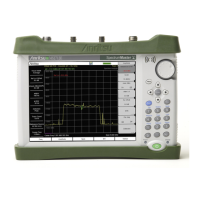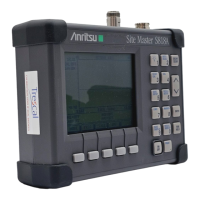2-18 In-Band/Out-of-Channel Measurements Spectrum Analyzer
2-24 PN: 10580-00349 Rev. H Spectrum Analyzer MG
2-18 In-Band/Out-of-Channel Measurements
The in-band/out-of-channel measurements are used to determine the distortion and
interference within the system band, but outside of the transmitting channel. These
measurements include in-band spurious emissions and adjacent channel power ratio (also
called spectral regrowth). There are stringent regulatory controls on the amount of
interference that a transmitter can spill to neighboring channels. To determine compliance
with the allowable level of spurious emissions, two parameters need to be specified:
• Measurement channel bandwidth
• Allowable level of spurious emissions
The measurements described in this section are distinct from the built-in emission mask
(in-band) measurements that are performed via the Masks and C/I submenu. See “Emission
Mask (In-Band)” on page 2-29.
Required Equipment
• 30 dB, 50 watt, Bi-Directional, DC–18 GHz, N(m)–N(f), Attenuator,
Anritsu 42N50A-30
• Test Port extension cable, Anritsu 15NNF50-1.5C
Procedure
1. Using the test port extension cable and 30 dB, 50 watt, (Bi-directional) attenuator,
connect the RF In port to the appropriate transmit test port.
2. Press the Freq main menu key, press the Center Freq submenu key, and enter the
center frequency.
3. Press the Span main menu key. Set the span wide enough to include the primary
channel bandwidth and upper and lower channel bandwidths.
4. Press the Amplitude main menu key and then press the Reference Level submenu key
to set the reference level to –20 dBm.
5. Press the RL Offset submenu key, enter 30 then select dB External Loss to compensate
for the loss in the attenuator.
6. Press the Auto Atten submenu key and set the attenuation to On.
7. Press the BW main menu key and use the RBW and VBW submenu keys to set the
resolution bandwidth to 10 kHz and the video bandwidth to 300 Hz.
8. Press the Marker main menu key and press the Marker 123456 submenu key to select
Marker 1. The underlined number indicates the active marker.
9. Press the On/Off
submenu key and use the arrow keys, the keypad or the rotary knob to
move the marker over one of the spurs.
10. Compare the value of the marker to the specified allowable level of
in-band/out-of-channel spurious emissions for the corresponding channel transmit
frequency.
11. Repeat steps 9 and 10 for the remaining spurs. Use either Marker 1 again, or choose
another marker.
ООО "Техэнком" Контрольно-измерительные приборы и оборудование www.tehencom.com
